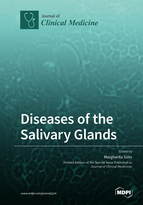Diseases of the Salivary Glands
A special issue of Journal of Clinical Medicine (ISSN 2077-0383). This special issue belongs to the section "Otolaryngology".
Deadline for manuscript submissions: closed (10 December 2020) | Viewed by 83657
Special Issue Editor
Interests: pathophysiology and molecular immunology applied to immunological research lines; molecular processes underlying the interaction between receptors of the immune response, inflammation and characterization of new anti-inflammatory molecules; novel therapies for Sjögren’s syndrome autoimmune disease; evaluation of the molecular mechanisms linking chronic inflammation to fibrosis in Sjögren’s syndrome and others autoimmune diseases
Special Issues, Collections and Topics in MDPI journals
Special Issue Information
Dear Colleagues,
Salivary glands (SGs) fulfill important roles in oral biology and the loss of normal SG function results in widespread deterioration of oral health, greatly impacting the quality of patients’ life. To date, no definitive therapeutic approach compensates for the impairment of SGs, and treatment is purely symptomatic. SGs were affected by a variety of diseases, local and systemic, and the prevalence of SGs diseases depends on various etiological factors. The glands may suffer from viral, bacterial, rarely fungal infections, which may cause painful swelling or obstruction, affecting their functions. The SGs may also be affected by various benign and malignant tumors which consist of a heterogeneous group of lesions with complex clinical–pathological characteristics. Overall, some serious problems for patients with SG diseases are often due to autoimmune diseases such as Sjogren’s syndrome (SS), a complex systemic autoimmune inflammatory disorder. This Special Issue entitled “Diseases of Salivary Glands” is intended to provide an overview of recent advances in the field of SG disorders and understanding the cellular and molecular mechanisms involved in the pathogenesis of SG diseases.
We cordially invite researchers, involved in basic research as well as in translational studies, to submit their original research, systematic reviews, and short communications to this Special Issue.
Prof. Dr. Margherita Sisto
Guest Editor
Manuscript Submission Information
Manuscripts should be submitted online at www.mdpi.com by registering and logging in to this website. Once you are registered, click here to go to the submission form. Manuscripts can be submitted until the deadline. All submissions that pass pre-check are peer-reviewed. Accepted papers will be published continuously in the journal (as soon as accepted) and will be listed together on the special issue website. Research articles, review articles as well as short communications are invited. For planned papers, a title and short abstract (about 100 words) can be sent to the Editorial Office for announcement on this website.
Submitted manuscripts should not have been published previously, nor be under consideration for publication elsewhere (except conference proceedings papers). All manuscripts are thoroughly refereed through a single-blind peer-review process. A guide for authors and other relevant information for submission of manuscripts is available on the Instructions for Authors page. Journal of Clinical Medicine is an international peer-reviewed open access semimonthly journal published by MDPI.
Please visit the Instructions for Authors page before submitting a manuscript. The Article Processing Charge (APC) for publication in this open access journal is 2600 CHF (Swiss Francs). Submitted papers should be well formatted and use good English. Authors may use MDPI's English editing service prior to publication or during author revisions.
Keywords
- Oral medicine
- Oral disease
- Salivary gland dysfunction
- Potentially malignant oral disorders
- Cellular and molecular pathway
- Autoimmune diseases







